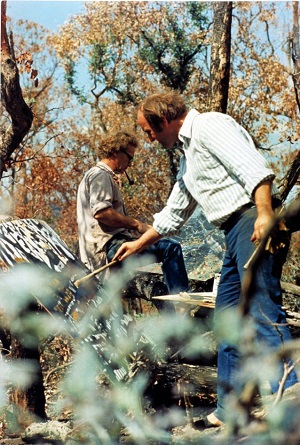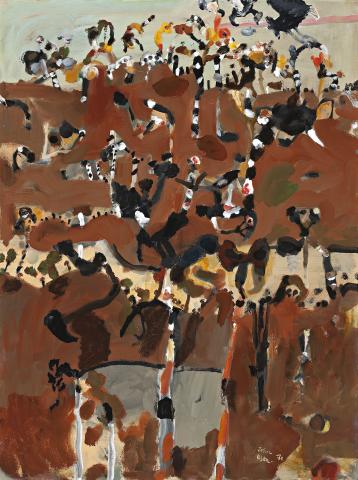COTTLES BRIDGE, 1970
JOHN OLSEN
oil on canvas
91.5 x 68.5 cm
signed and dated lower right: John / Olsen 70
Private collection, Melbourne
Gould collection, Melbourne
The Director's Choice 2006, Gould Galleries, Melbourne, 8 February – 26 March 2006, cat. 14 (illus. in exhibition catalogue)
The Director’s Choice 2012, Gould Galleries, Melbourne, 19 July – 31 August 2012, cat. 12 (illus. in exhibition catalogue)
2. Strizic - Olsen, Pugh Dunmoochin, 1969.jpg

Cottles Bridge, 1970 belongs to a distinct and powerful group of paintings within John Olsen’s oeuvre, a significant period which heralded a marked change in his approach to the Australian landscape. The year before it was painted, Olsen relocated from Sydney to Victoria, taking up residence at ‘Dunmoochin’, a community collective in Cottles Bridge. This had been co-established by the artist Clifton Pugh in the early 1950s and extended to 205 acres at its peak. Olsen and his family moved into one of the mud-brick buildings whilst he utilised another as his painting studio. In contrast to the fecund landscape around Sydney Harbour, Cottles Bridge is ‘characterised by dusty, rolling hills, eucalypts, bright-yellow wattles and numerous spherical dams’,1 one of which, near the entrance to the property, is depicted at the base of the painting offered here. ‘Dunmoochin’ was an incredibly vital place during the late 1960s and early 1970s populated at times by prominent political figures such as Gough Whitlam and Sir John McEwan who had commissioned portraits done by Pugh. Other artists also joined the fray including Fred Williams, John Perceval and Albert Tucker, all of whom would paint, draw or photograph together as they created their own distinctively individual visions of the land.
With Pugh, Olsen purchased an etching press and also started collaborating with the potters Robert Mair and Tom Sanders, decorating and glazing items made by them.2 Inevitably these attitudinally and physically different methods of mark-making started to inform Olsen’s own painterly technique with the result that paintings such as Cottles Bridge feature somewhat blunter marks of impasto paint pushed around on the canvas surface. Prior to this, his celebrated Sydney paintings were articulated through jumpy, tangled, tendril lines bristling with the very energy of the location they sought to portray. Importantly, they included references to incidents, characters and even animals negotiated along the way; and the birds seen enmeshed within the paint surface of Cottles Bridge appear to have met a similar fate through their encounter with the artist’s brush. In a revealing passage from his 1969 diary, Olsen wrote of one painting excursion with his companions that ‘(w)e don’t necessarily copy what is in front of us when we are out there, not at all; it’s the feeling of the landscape that we want, and its unimaginable details. Fred, for instance, makes a straight horizon-line, no matter how hilly the country is. Clif finds apostle birds and bush orchids wherever he looks… I tie a canvas to a tree and see the country in terms of the ‘dragon veins’ lacing the female principle, the Yin.’3
Olsen’s interest in Zen philosophy was well noted by this time and places an emphasis on the dual yet opposite principles of emptiness and fullness. Cottles Bridge teases out this duality through the artist’s use of a heightened eye-level which flattens the landscape yet simultaneously tilts it to an alarming angle, a visual effect the artist would bring to fruition in subsequent paintings based on Lake Eyre. In hindsight, the two years at Dunmoochin formed a necessary period of concentrated meditation for Olsen and precipitated a reorientation of his own attitudes to painting, a strategically successful undertaking which resulted in him winning the prestigious Wynne Prize for Landscape Painting in 1969 with The Chasing Bird Landscape (Westpac Corporate Art Collection, Sydney).
1. Hart, D., John Olsen, Craftsman House, Sydney, 2000 (2nd edition), p. 95
2. Perceval and Pugh had previously re-sited the old kiln from the AMB Pottery in Murrumbeena up to a studio at ‘Dunmoochin’
3. Olsen, J., diary entry July 1969, quoted in: Olsen, J., Drawn from Life, Duffy and Snellgrove, Sydney, 1997, p. 71
ANDREW GAYNOR
